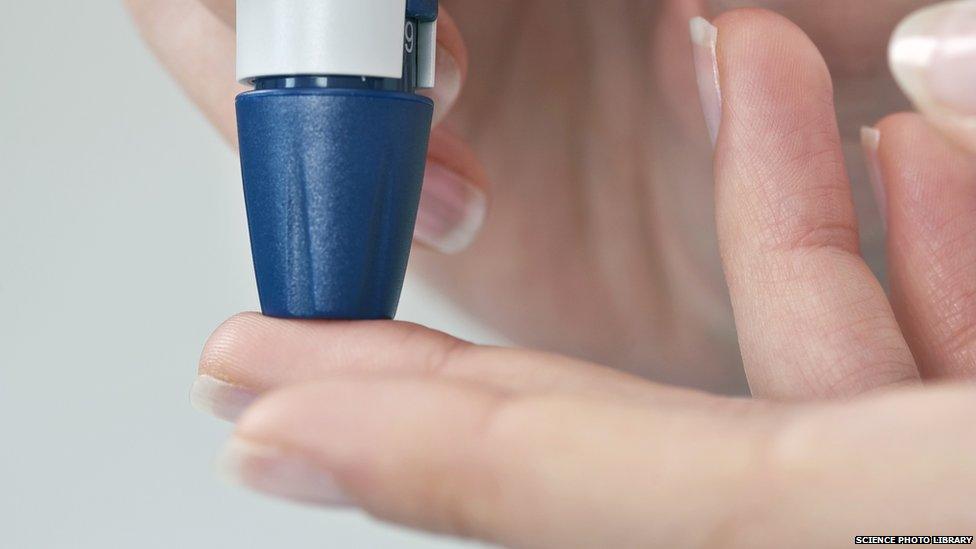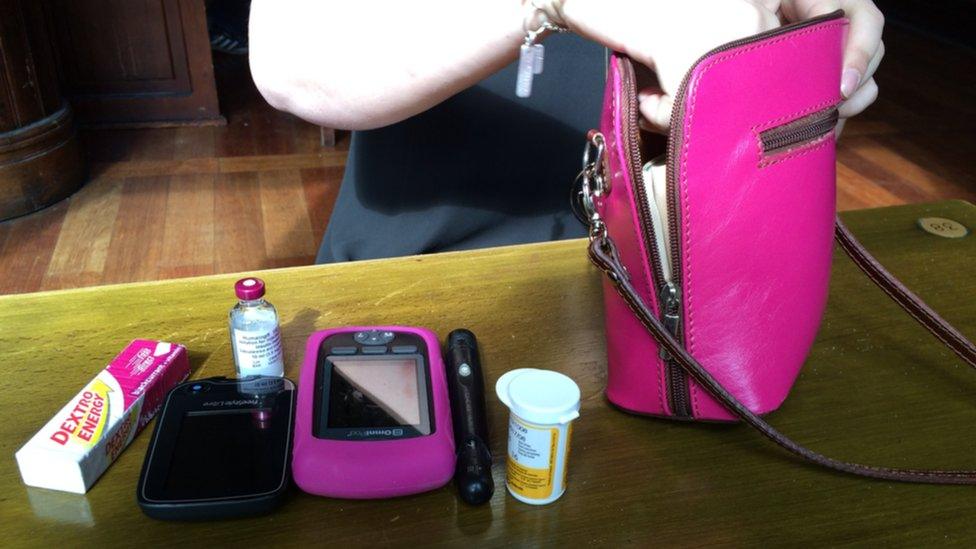'I have type 1 diabetes and it isn't because of my diet or weight'
- Published

With the WHO reporting a fourfold increase in the number of people living with diabetes since 1980, the role poor diet and lack of exercise has in causing the condition is back in focus.
Despite eating well and playing hockey, 19-year-old Lydia Parkhurst has type 1 diabetes.
"It isn't about diet," she explains.
"Type 1 diabetes is an autoimmune disease where your pancreas stops working properly."
BBC Advice has more help and information about diabetes.
Because her pancreas no longer produces insulin, Lydia has to monitor her blood sugar levels throughout the day, and make sure enough insulin is being injected into her body.
Type 2 diabetes is mainly driving the increase reported by the WHO and this is caused by a variety of factors, which can include obesity.
Not all countries in the world have the resources to do the tests which are required to distinguish between type 1 and type 2, which is why global estimates for them as distinct conditions "do not exist", according to the WHO.
"It's important to make the distinction between the two because type 1 is not due to lifestyle choices," says Dr Peter Hindmarsh, a specialist in childhood and juvenile diabetes from University College London Hospitals, external.
"This is a condition which we don't really know the cause of but it's where the body turns against itself and destroys the insulin-producing cells."
If diabetes isn't cared for properly it can cause a variety of problems, such as damage to eyesight or kidney function.
And if Lydia's blood sugar levels fall too low she could end up in a diabetic coma.

People have objected to images like this because the usual advice is to use the side of the finger for prick tests
According to JDRF, the charity dedicated to type 1 diabetes research, about 400,000 people in the UK live with condition.
Lydia says she gets frustrated when the media and celebrities blame an unhealthy lifestyle for the rise in diabetes.
"I think the stigma around type 2 is really bad as well," she says.
"My grandad got type 2 from a secondary illness. It had nothing to do with his weight.
"That's the same thing that happens with type 1 - people think it's down to the way we eat and that we haven't exercised and that's not true."
Not all cases of type 2 diabetes are linked to lifestyle factors, according to JDRF and, like type 1, there is a significant genetic factor in developing the condition.
It is not just stigma about lifestyle which the diabetes community finds frustrating - it's also the statistics quoted about life expectancy.
"There was - and still is - quoted a 23 year reduction in lifespan," says Dr Hindmarsh.
"That was based on a lot of old data."
Newer studies reported recently suggest the difference in life expectancy for people with type 1 compared to the general population is 12.2 years.
But according to JDRF these headlines "obscure" the fact new treatment options have closed the gap.
Dr Hindmarsh says those with well-managed type 1 diabetes can expect a comparable life expectancy to those without the condition.

This is some of what Lydia must carry every day to manage her diabetes
Type 1 diabetes means Lydia, a geography student, "never" leaves the house without her handbag.
Along with keys and a phone, it also contains the devices which keep her alive. One controls the amount of insulin going into her body, another reads her blood sugar levels.
Lydia also carries testing strips, a vial of insulin, a needle to prick her finger, glucose tablets and a spare insulin pump for her arm.
"I know quite a few of my type 1 friends who are men have a manbag," she says. "You've always got to think of your health first."
When she wears just a T-shirt, the pump and the sensor are visible - one on each arm. The pump is the size of a strawberry, while the sensor is the size of a 2p coin.
These plastic devices are what keep Lydia alive. She's got so used to them, she mostly forgets they are there, sometimes knocking them on the door frame.
"It's happened once or twice where somebody's passed by and said, 'That's disgusting, that's awful,'" she says.
"You just have to ignore them though, because at the end of the day, they're not the one living with it."
The sensor which measures her blood sugar is not available on the NHS. Lydia spends about £100 a month paying for that herself.
She still has to do a finger prick test once or twice a day to check her blood sugar levels. Before she got the sensor she had to do this at least every couple of hours.
A small proportion of children and young people - somewhere between 500 and 800 at present in the UK - who are diagnosed with diabetes, have type 2.
"We've certainly not hit the proportions which are present in the United States," says Dr Hindmarsh.
"It's probably a slightly different condition to the one which evolves in adults, but if you're presenting with the features of type 2 diabetes as a child or young person, then things have gone pretty awry," he adds.
"There is a considerable social stigma associated with type 2 diabetes," #GBDOC, external, a diabetes support organisation, tells Newsbeat.
"Many of our community have come forward in the past to talk publicly talk about the condition only to be mocked, ridiculed and targeted through social media for 'bringing it on themselves.'"
Find us on Instagram at BBCNewsbeat, external and follow us on Snapchat, search for bbc_newsbeat